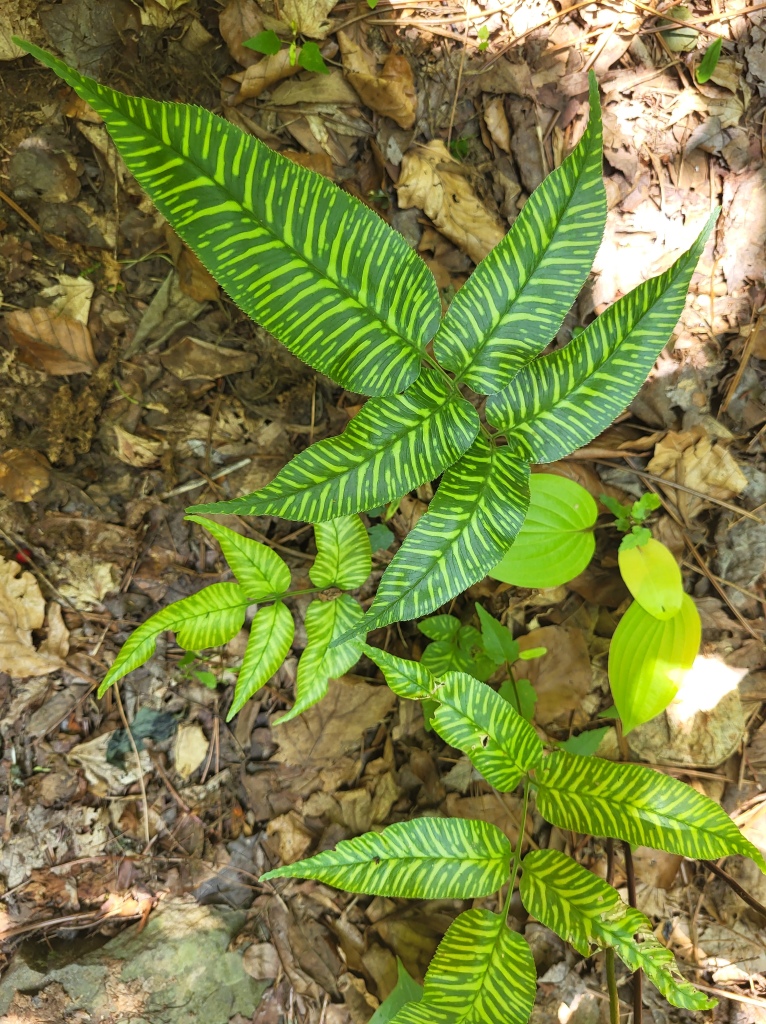I do my small part, though more to selfishly attract wildlife for personal enjoyment than to do my minute part in delaying our warming climate. I feel only slightly guilty that I enjoy our warming winters, but also that the years without extreme freezes have enabled me to add plants that I long expected not to survive temperatures that once regularly fell to zero (Fahrenheit) and below.

The garden’s collection of ferns has multiplied to dozens in recent years while observing ones that flourish in dry or damp shade as I strive for ideal placement. Two ‘Golden Zebra’ Bamboo fern (Coniogramme emeiensis ‘Golden Zebra’, above) were planted a few years ago, expecting both would perish the first winter. And, they did, or at least I thought so until the two reappeared this spring from under dense foliage. I’ve now cleared space for one as I consider how to better display the second.

While not challenged by the cold, the wooly lipfern (Cheilanthes tomentosa, above) was a recent addition to the sunny rock garden. Our current dry spell has tested its resillience as it’s been rescued from the brink several times. Its fronds curl to play dead when dry, but I suspect the newly planted fern was revived at the last moment when I returned from ten days away.
I do not to jump onto the bandwagon that every weather event is due to a changing climate. Perhaps, but occasional droughts are recalled through the thirty-four years tending this garden, so more evidence is required. The data confirming ever milder winters is concerning.

A drop to six degrees in December at least temporarily dispelled notions that our climate zone could fall another notch (once zone 6b, now 7a, soon 8a?), but still, bigleaf hydrangeas (Hydrangea macrophylla) were damaged by the abrupt fall in temperature. The last of non-remontant hydrangeas (flowering only on last year’s growth) will be dug out as soon as a suitable replacement is decided upon. Reblooming hydrangeas are now in glorious bloom (above) on buds developed this spring after the damaged stems were pruned away.

The abrupt drop in temperature did not bother the variegated ‘Spider’s Web’ fatsia (Fatsia japonica ‘Spider’s Web ‘, above) or the marginally cold tolerant Schefflera delavayi (below). The fatsia survives, though it does not thrive, while the schefflera is finally gaining the size to make me question its proximity to the primary path to the rear garden.

Flowering of the Australian native grevillea (Grevillea victories ‘Murray Valley Queen’, below) was cut short by falling temperatures the third week of December, but not a leaf was damaged as it sailed through six degrees, but an otherwise mild winter. It is also due for a chop before it grows to obstruct the path, but each year I become more confident in the long-term survival of these plants that I once considered tropicals. All were nearly cold hardy for the garden, but it seems now they are here to stay.

Tucked into the raised planting area in the lower, rear garden is a large mangave that is dug for the winter and stored in the basement along with several others. The crosses of agave and manfreda are variably cold hardy, but so far I don’t trust that any are sufficiently hardy enough to be left outdoors. While I’ve recently planted a manfreda that claims cold hardiness, I hope that our winters don’t change enough so that I’m comfortable leaving the mangaves outdoors.
